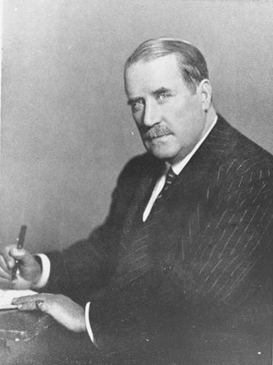Jocelyn Field Thorpe facts for kids
Quick facts for kids
Jocelyn Field Thorpe
|
|
|---|---|
 |
|
| Born | 1 December 1872 |
| Died | 10 June 1940 (aged 67) |
| Nationality | English |
| Alma mater | Heidelberg University |
| Known for | Thorpe reaction Thorpe–Ingold effect Guareschi–Thorpe condensation |
| Awards | Longstaff Prize (1921) Davy Medal (1922) |
| Scientific career | |
| Fields | Organic chemistry |
| Institutions | Imperial College London |
| Doctoral advisor | Karl von Auwers |
| Doctoral students | Christopher Kelk Ingold |
Sir Jocelyn Field Thorpe was a brilliant British chemist. He was born on December 1, 1872, and passed away on June 10, 1940. He made many important discoveries in organic chemistry. This is the study of chemicals that contain carbon. Some of his key contributions include the Thorpe–Ingold effect and three chemical reactions named after him.
Contents
Early Life and Education
Jocelyn Thorpe was born in Clapham, London. He was one of nine children in his family. From 1888 to 1890, he studied engineering at King's College, London.
He then decided to switch to chemistry. From 1890 to 1892, he studied at the Royal College of Science. He later earned his Ph.D. in organic chemistry in 1895. He studied at Heidelberg University in Germany.
After finishing his studies, Thorpe joined Owens College, Manchester. This college later became part of the University of Manchester. He started as an assistant and quickly became a lecturer. In 1908, he was chosen as a Fellow of the Royal Society. This is a very high honor for scientists.
Career and Discoveries
In 1908, Thorpe moved to the University of Sheffield to focus on research. In 1913, he became a professor of organic chemistry at Imperial College London. He held this important job until 1939.
At Imperial College, he worked hard to improve the chemistry department. When World War I started in 1914, he used his skills to help. He worked on committees that developed chemical defenses. He also helped create new medicines. These included phenacetin and novocaine, which are used to relieve pain.
After the war, Thorpe continued his important research. He also advised many government and industry groups.
The Thorpe–Ingold Effect
One of Thorpe's most famous discoveries is the Thorpe–Ingold effect. He worked on this with Christopher Kelk Ingold. Ingold was a researcher in Thorpe's department.
They noticed something interesting about carbon atoms. If you make the parts attached to a carbon atom bigger, other parts of the molecule react faster. This discovery helped scientists understand how molecules behave.
Chemical Reactions Named After Thorpe
Three important chemical reactions are named after Jocelyn Thorpe.
- The Thorpe reaction is a special way to make new chemicals. It involves certain organic compounds called nitriles. They react together with the help of a base to form new structures called enamines.
- The Thorpe–Ziegler reaction is a version of the Thorpe reaction. It happens inside a single molecule. This reaction can create ring-shaped molecules called ketones.
- The Guareschi-Thorpe condensation is another reaction. In this reaction, two different chemicals combine. They form a type of compound called a 2-pyridone.
Awards and Honors
Jocelyn Thorpe received many awards for his scientific work.
- In 1908, he became a Fellow of the Royal Society.
- In 1917, he was awarded the CBE. He also became a member of the Officier de la Légion d’honneur from France.
- In 1921, he became the Vice-President of the Chemical Society. He also received its Longstaff medal.
- In 1922, he was given the Davy Medal by the Royal Society.
- From 1928 to 1931, he served as President of the Chemical Society.
- In 1939, he was made a Knight (KBE). This means he was given the title "Sir."
Personality
People who knew Jocelyn Thorpe described him as a cheerful and creative person. He loved working in the laboratory. He was often seen in his shirtsleeves, even smoking a cigar, while looking closely at test tubes.
His friends remembered him as kind and caring. He was also interested in art and culture, especially English china. His wife, Lilian Briggs, whom he married in 1902, supported him throughout his career.

